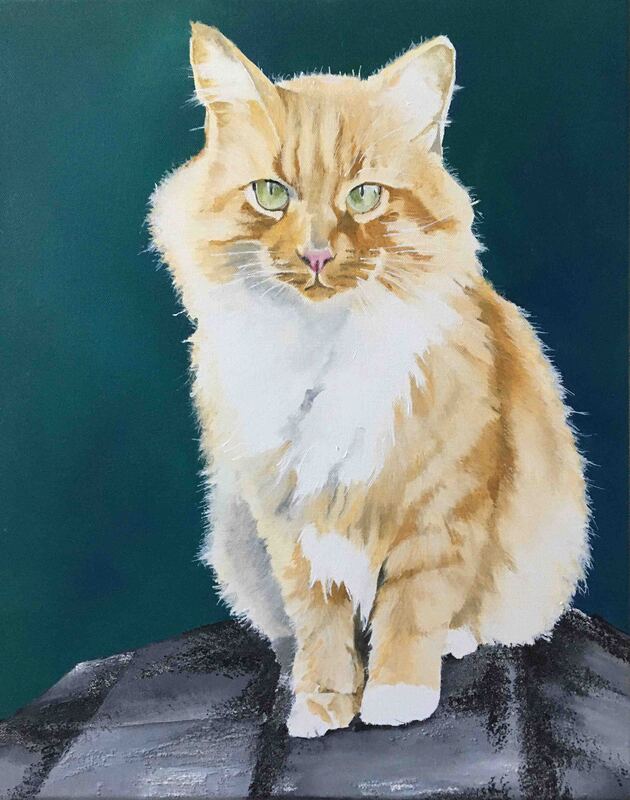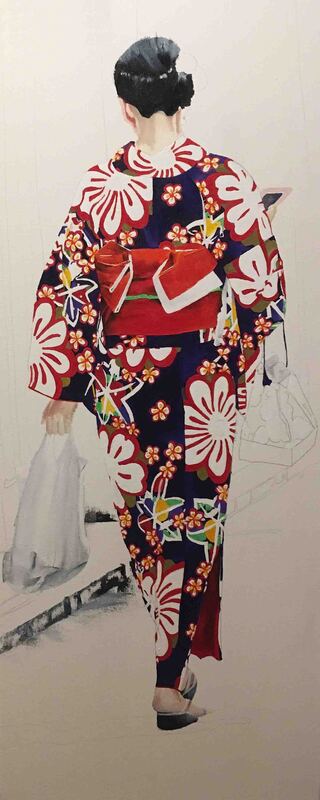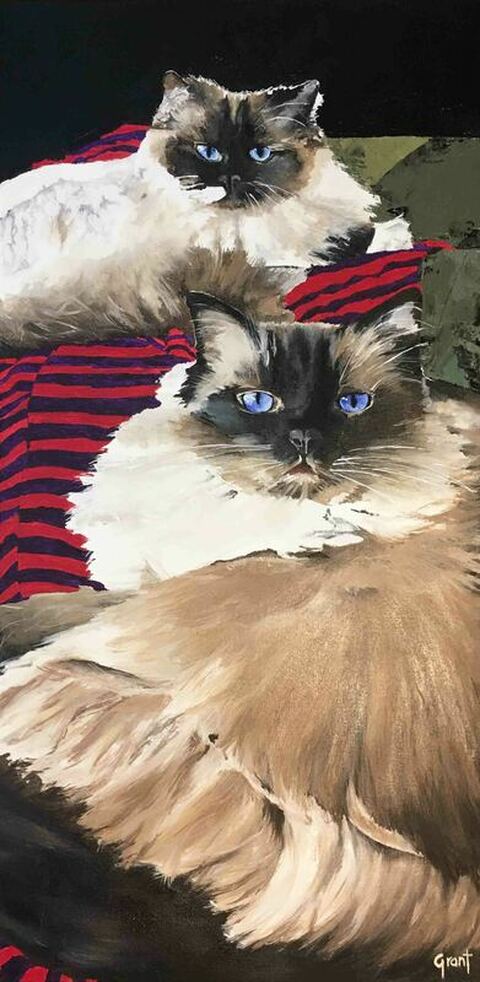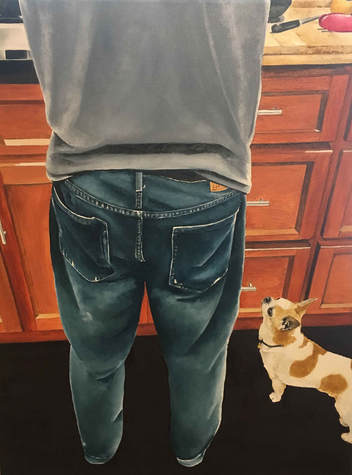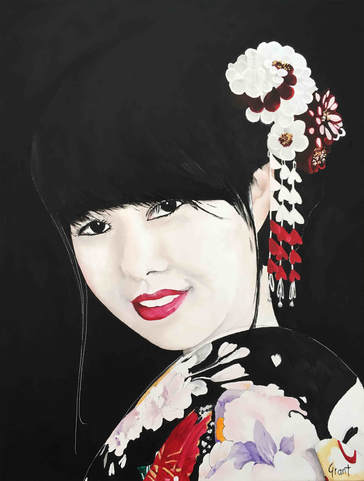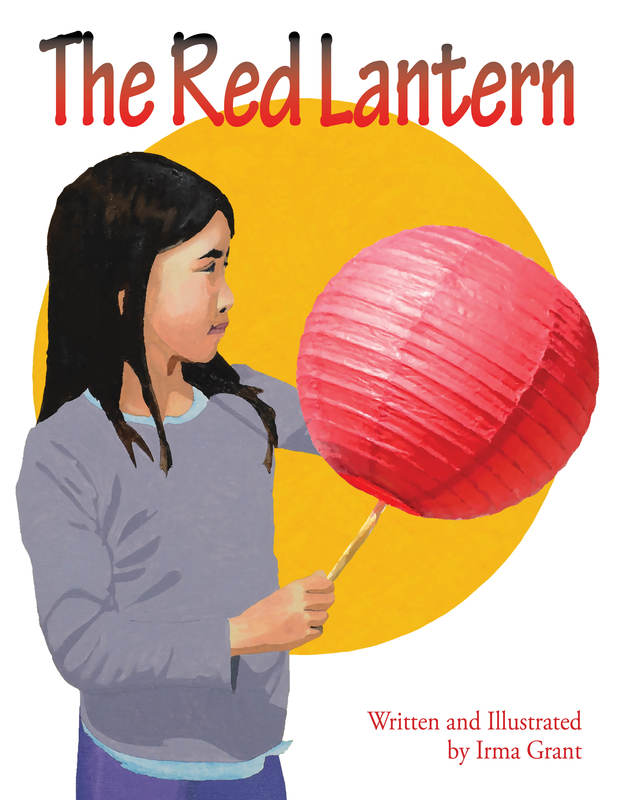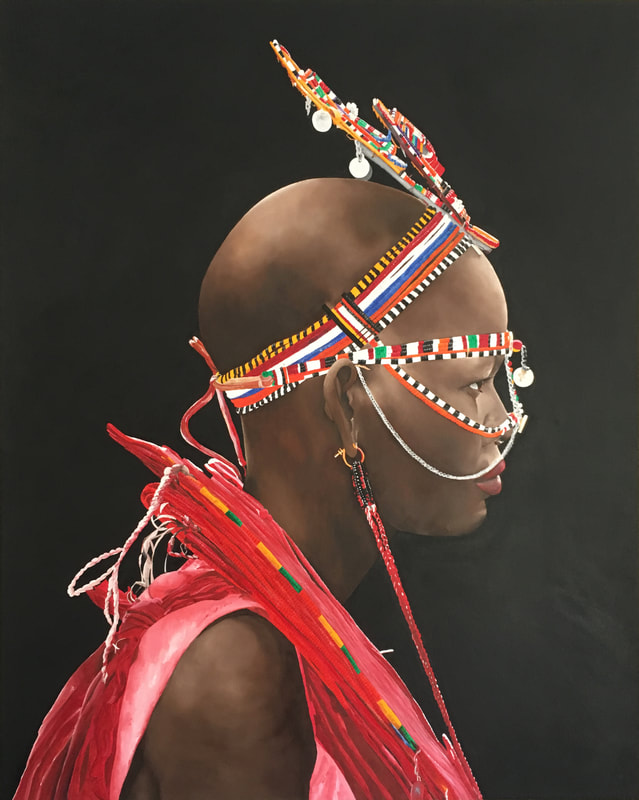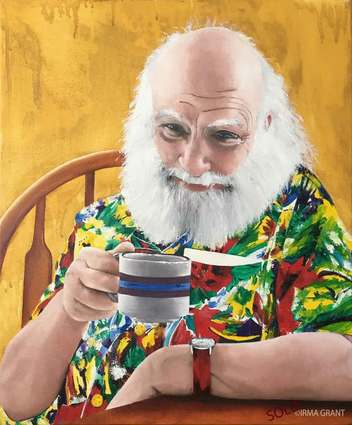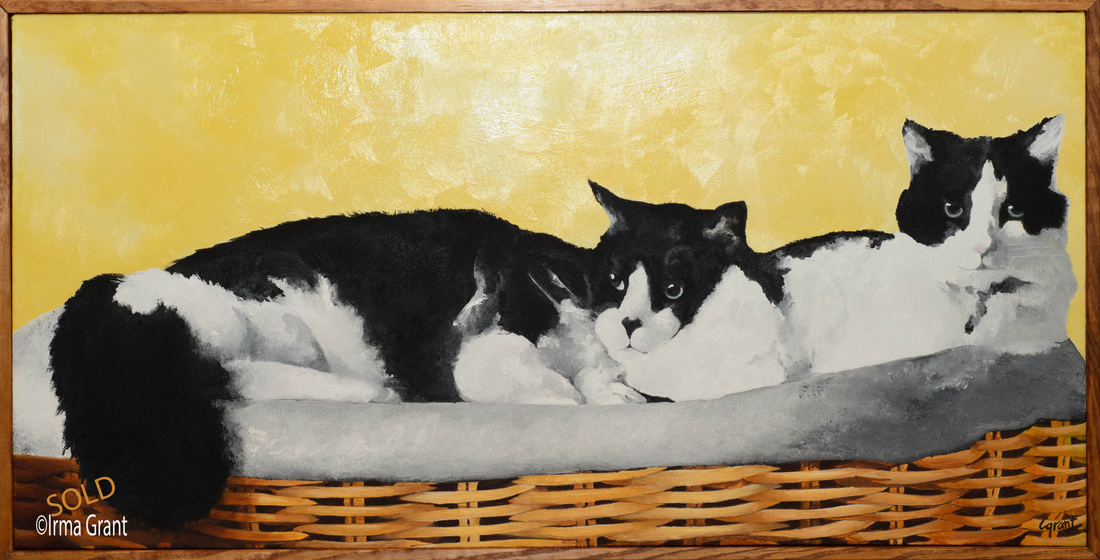0 Comments
This last month I participated in a MOMA studio art class where we were introduced to different artists from the New York School of Expressionism. Before reading the title and description, see how many abstract expressionist artists you can correctly identify: ZIP: 12" x 36" Acrylic on Canvas First, I painted the entire canvas with two coats of Liquitex Acrylic Cerulean Blue Hue. Then, I taped two strips (one for each zip) and painted the rest with Phthalocyanine Blue (green shade). It again, needed two coats. Once I removed the blue tape, I realized that the zip impressions matched the blue color from the blue tape. Then, I tried the two different methods of zips: (1) taping two strips and painting in between with a Light Portrait Pink and (2) taping one strip and adding a zip with a palette knife. For fun, I added a small green zip at the edge of the canvas. I now understand Barnett Newman's obsession with making straight zips. It's not as easy as it looks. I ended up adding more zips to the right of my painting as the left zip is slightly off. More zips would have highlighted the 'offness.' Araignée: 48" x 60" Oil and Enamel on Canvas This was so much fun! After watching a few videos on YouTube showing Jackson Pollock in action, I tried to follow his various steps on how he approached the canvas. I don't smoke, so had little, long Espresso breaks in between the various layers. Given what I know of Pollock, I don't think he waited for each layer to completely dry. He didn't have the patience for that. I used string and sand, turkey baster, thin and wide paint brushes but enjoyed the mixing stick from Home Depot the best. What I like about the painting in the end are the alligator skin effects and the textured feeling of the canvas. The paints shrunk in place. However, it did leave a few cracks, small ones on the heavy loaded areas. I'm sure these are the cracks that called Pollock back into maybe adding more layers in the end. It's a heavy painting and I see why Pollock liked commercial enamel house paint. It flows. 24K: 24"x24" Gold Gilded and Acrylic on CanvasI was very lucky to visit MOMA San Francisco last weekend and indulge myself in Agnes Martin's Octagonal room with 7 of her paintings: "Wheat," "Drift of Summer" and the rest "Untitled". In the end, I decided to use her painting "Friendship" as an inspiration. I love colors. I did not use real gold, too expensive, but ended up with imitation gold leafs. I'm sure Agnes carefully glued the leafs on the lines she wanted. I wasn't that careful and hence, the edges of the gold leafs do come through in certain sections of the painting. Oops! The lines kind of happened. Again, I wasn't that careful and as you can tell from the photo, I miscalculated the distances for the vertical lines. I used a potato knife to 'chisel out' the gold, exposing the red under paint. Then, I painted the white lines on top (Newman Style). Infinity Net: 36" x 48" Oil on CanvasIt’s very therapeutic covering a canvas with white arches. While painting Yayoi Kusama’s inspired "Infinity Net," I couldn’t help but think of the chicken and egg debate: Does Ms. Kusama's mental illnesses channel her art or does her art channel her mental illnesses? The obsessive-compulsive repetition of painting small loops that go on and on is mesmerizing but I don’t think I could do this for days, or even months on end like Ms. Kusama. Black Whole: 24” x 12” Oil on CanvasI’m not sure I properly followed Ad Reinhardt's method. The demonstration video showed that the pre-prepared paint, with most of its binder (linseed oil) removed, would dry quickly. Well, my paint took hours to dry, prompting me to dust off the heat gun. This helped speed up the drying, but I still needed to repaint each square a number of times – often removing the previous layer. Maybe it was the cheap canvas? Who knows? I decided to frame the canvas before painting as finger prints would show if touched – even when dry. After multiple attempts, here is my Ad Reinhardt inspired painting of “Black Whole (With the ‘W"). Don’t think I’ll ever use this technique again. I understand why Ad decided to paint this way: the subtlety of the matted black colors is mesmerizing and you really have to take your time to notice the different hues of black. Untitled 2020: 40" x 30" Oil on Canvas This Marc Rothko inspired painting made me struggle, encouraged me to think outside the box, required a load of paint, and lots of wiping, removing, and cleaning.
I had a vision of doing a rectangular band in the center of the canvas with a slightly darker version for a background color: an extension of Rothko’s later work. My first mistake was, I started out with a Cadmium Yellow Deep Hue oil paint mixed with linseed oil to make it flow better. It looked wonderful – for a background. After letting it dry, I decided it needed a darker background, and I painted over the entire canvas with an Alizarin Crimson oil paint mixed with Dammar Varnish. Oh, boy, did it smell up the house. It dried fast though and I was left with a darker background. Gone was my happy Cadmium yellow. Then, the experimentation began. I tried painting a portal hole with a slightly darker maroon: my original vision. It was too plain. I added more colors to the canvas, only to remove it a day later. I liked the results of mixing a cold wax medium into the paint to give it a more muted look. I placed various versions of Cadmium Yellow on the top. I mixed paint with mineral spirits and removed paint with mineral spirits. My Rotko inspired painting went through many transformations. In the end, I’ve come to realize that Rothko didn’t just paint his canvases, he stained them. I will definitely use some of his techniques in future projects. Every time we go on a vacation, I make time to sketch simple, pencil drawings. I always promise myself that when we get home, I will continue to make the effort to find time to draw, only to have life’s ‘other’ responsibilities take over.
We were very fortunate to be able to get away this summer by renting a fully equipped RV Camper Van and driving to Grand Teton and Yellow Stone National Parks. The only time we found ourselves exposed to COVID-19 was when we ventured into grocery stores, something we would have had to do at home too. The rest of our time was spent camping in the open wilderness, hiking, and swimming in deserted rivers. Being off the grid gave me the time, space and peace of mind to pick up a pencil and drawing pad. Above are sketches of some of my favorite moments in the mountains. I’ve also added sketches from last summer’s stay in the French and Swiss Alps – a time and place that seems so, so far away right now. COVID-19 has given me time to catch up on some long overdue commissions: Ricky, a well loved red tabby cat, and Morgan and Samson, two German Shepherds.
I first painted Morgan and Samson last year but was very unhappy with the background color. It made the shepherds coat look too washed out. After putting it aside for a long while, I redid the entire painting with a different wash and I am much happier with the result. Frontline: Six Feet Apart is anchored into the American fabric, within a world context. I used the colors of the American flag: red, white and blue. The background is painted blue, the color of the sky and sea. Blue is also the color of the protective gear worn by Covid-19 first responders, producing a calming effect. White is associated with light, faith and safety. The color red represents oxygen rich blood, energy and love.
I textured a world map as the first layer, with the American continents front and center, showing Asia to the West (left) and Europe to the East (right). Covid-19 has no borders, no race, and no shame. Next, I painted the lungs. Covid-19 is a respiratory disease, attacking the lungs and making it impossible for the host to breathe in the worst cases. Lungs look like tree branches, and like trees, exchange oxygen and carbon dioxide in reverse. Lastly, and most importantly, I want the viewer to witness the human face behind the Covid-19 epidemic – the face behind all the protective gear. I want this painting to commemorate FRONTLINE health care workers: true American heroes. I don’t know the name of the health care technician who collected my nasal swab at the Alameda fairground drive-through testing site. She was friendly and didn’t mind me taking her picture. I do know that I admire her resilience and her strength to confront the Covid-19 virus with a comforting smile on her face. And, if you look very closely, she bears the weight of San Francisco on her left shoulder. The first of the Geisha series, Japan’s symbol of beauty and mystery. Loved seeing all their vibrant colorful kimonos while visiting Kyoto, the heart of Japan’s Geisha world.
DUBLIN, CA
I decided to focus my proposal for the “History of Travel through Dublin” utility box design on “the wheel” and place it in the time of when cars first made their appearances here in Dublin, California. Throughout history, most inventions were inspired by nature: the idea of forks came from forked tree branches and planes from birds. Not the wheel. The wheel is 100% a 'human' innovation. It took a long time for the wheel to be invented and the first wheels were created not for transportation but to serve as potter’s wheels. The ancient Greeks eventually invented the wheelbarrow, a one wheeled, hand drawn vehicle. Most people recognize the vintage car as an historical image of transportation. I added an old bicycle to highlight the fact that it was a bicycle mechanic, Henry Ford, who invented the first car using advanced bicycle technology. To humanize the history of the wheel, I adding one person into the image: a child playing a game with an old tire. It was the wheel that led to the first bicycle that in turn led to the first car. All three (tire game, bicycle and car) represent a common time period in the history of travel through Dublin. Dublin has dry, hot summers and is bordered by Mount Diablo and the Ridge. I used the colors purple, burnt sienna, yellow, and van Dyke red against a mountainous background. The silhouettes provide a sense of bygone days. CLEMSON Oil on Canvas 30" x 24" Welcome to the “Artful Animal” club Clemson. It was a joy painting you in oil on canvas. You’re a beautiful horse who’s sweet, smart, talented, and will do anything for treats. Enjoy your rides with Madisyn in the outdoor arena.
I’m very excited to showcase the first five boats, in a series of six, hanging at Nonni's Bistro in downtown Pleasanton. My goal for the boat series is to capture traditional sailing boats and dug out canoes ‘in action’ and cementing them in oil on a canvas for future generations to read. Dugout sailing boats and outriggers are the oldest boats around and continue to be used in many parts around the world for fishing and transportation. The knowledge of how these boats are build and the traditional link they provide with the sea are quickly getting lost with the rapid rise of globalization. Update: The show was very successful as I managed to sell 7 paintings. Phew!
While driving home today, I followed a car with the license plate “IS 66.” I guessed by the added flag sticker that “IS 66” meant Iceland located at 66 degrees latitude. How appropriate, the day I finished painting Icicle, the Icelandic horse with the 80s punk rock hairdo.
Three summers ago we stayed at a converted sheep farm where Icicle roamed the surrounding fields. Iceland is covered with over 80,000 Icelandic horses. Not bad for an island you can circumnavigate by car in one day – one long day. Why so many horses? Icelanders don’t eat horse meat. Turns out they are mostly used for breeding, exporting and enjoyment. Our girls couldn’t get enough of Icicle; feeding him grass in the cold summer winds and petting his puffed up mane. They even got to ride Icelandic horses, a highlight of our road trip. It was Icicle’s big hairdo that attracted me to put him on canvas: A kind reminder of our time north of 66. PEDALS IN THE WIND “Stop putting graffiti on that box,” yelled a lady as she was driving through the traffic light. This was the second day of painting my third utility box: “Pedals in the Wind.” I tried to explain to her that it was part of the city’s utility box beautification program called “Project Paint Box.” She didn’t buy it. Her comment made me think about art versus graffiti. Is graffiti art? Is it always vandalism? What is art? What is street art? What is graffiti? Banksy, an anonymous English graffiti artist, uses stencils and spray paint to spread messages of art and politics on crowded city streets, walls, and bridges. His name and identity remain unknown – graffiti is a crime. However, in 2010, Time Magazine featured Banksy as one of the 100 most influential people in the world. Utility boxes have flowered into some of the best showcases for public art. To deter them from graffiti, cities around the world are asking local artists to use them as a canvas for artistic expression – with council prior approval of the design. The lady that thought I was defacing the utility box with graffiti did return to apologize. She was trying to be a conscientious citizen. That was very brave of her. Street art will continue to spark debate: Is it art? Is it graffiti? I would love to hear Banksy’s take on it one day. On behalf of myself and the city of Pleasanton, I'd like to thank Bob and Joanne Rossi Becker for sponsoring another box. Kudos also go to Robbie Helms at Valley View Elementary School for coming up with the awesome title: “Pedals in the Wind.”
Meet Lintilla, our newest member to the "Artful Animals" family. Can you guess her favorite color?
Lintilla is a much loved cat who lived a relatively quiet life up until a number of years ago when a small dog was adopted into her home. Forget about sleeping on the big bed. Forget about curling up on the couch for a mid-morning nap. Forget about lying on the window sill to bask in the late afternoon sun. The only safe place in the house, high enough, turns out to be the bathroom sink – her favorite hang out place. The original photograph is of Lintilla enjoying her perch on the sink vanity; however, this unattractive background has been exchanged with a wash of her favorite color – purple. This is a portrait of Klara, peaking from behind a tree. The photograph was taken by a friend while on one of our many camping trips. She didn't wear glasses yet but pink and purple are still her favorite colors. Below is a 2-minute time lapse of me painting Klara's portrait. Enjoy! Spring air - woven moon and plum scent. - Matsuo Basho (Japanese Poet) This portrait is of a Japanese bride, wearing a simple, floral kimono and a delicate flower-motif hair ornament, kanzashi, made of silk plum blossoms. The plum blossom holds a special place in Japanese traditions: it represents spring, a time of new beginnings, and is associated with beauty, purity, hope and the transitoriness of life.
Many came to celebrate the launching of The Red Lantern and viewing of the oil paintings, the basis for all the illustrations in the book, at the Firehouse Theater. Thank you Judy at Towne Center Books for suggesting and offering your space for the book launching party; thank you Julie at the Firehouse Theater for showcasing the oil paintings all month long; and thank you to all my dear, dear friends for coming out to support me this morning.
60" X 48" OIL ON CANVAS
I’m ecstatic. It’s finally here. Seeing my book officially displayed on Amazon, sends ripples down my spine. Thank you to the many friends and colleagues in the teaching and book business profession who read and critiqued The Red Lantern. It has come a long way and I’m proud of the final version.
The idea for this book started with an antique ginger jar. A former student of my had spent the summer at her grandfather’s antique shop in Hong Kong. When she saw the ginger jar, it reminded her of me and she kindly brought it back as a gift with a note: “Ma chère ancienne professeure.” I had hoped to set the story in Hong Kong with a ginger jar genie. Turns out there are no genies in the Chinese culture. Eventually, the ginger jar got replaced by a red lantern; the genie by the Jade Emperor’s daughter, and the genie’s three wishes became three lantern riddles. It was very fitting to tie the story into modern day Chinese New Year and the lantern festival. This book is the perfect gift for young children, teachers interested in celebrating Chinese New Year in their classroom, and grandparents who need a souvenir to bring home to their grandchildren after visiting San Francisco’s China town. Please order a copy of The Red Lantern and take a few minutes to rate it on Amazon. My first art exhibition was in Middle School when three different projects of mine were framed and hung on the school’s hallway walls. You never forget that feeling of pride, knowing someone liked your work enough to hang it on a wall for all to see. Soul Searching is not my first exhibition as I’ve been part of group, solo, juried and non-juried shows in the past. However, The Spirit of Africa and the Diaspora feels like my first “coming out” show. The four African portraits I painted, managed to take me back 30 years, when a college friend, who grew up in Kenya, introduced me to the Swahili song “Jambo Bwana” on her cassette player while cruising through downtown Vancouver. We thought we were being really cool. I fell in love with Africa the first time I saw the movie Out of Africa, starring Robert Redford and Meryl Streep. This was followed by receiving my first A+ mark for an English composition based on the novel by Joseph Conrad Heart of Darkness. Not many years later, I found myself traversing the African continent on our honeymoon, camping in some of the most incredible spots in the world. My hope was to capture that young, free, adventurous spirit in these portraits. The Maasai warrior represents strength and ownership. He reminds me of an experience where we met a group of local Batu men while traveling the Serengeti. These hunters were on their way into the desert, carrying spears and poison arrows, dressed in business suits while riding their bicycles – some had doubled up. Maasai had taken their cattle the night before and it was time for revenge. The Maasai believe that God gave them all the cattle in the world; hence they were just taking back what belonged to them. However; the park warden stopped them, at least long enough until we were out of sight. The Maasai bride symbolizes passage and union. She is on her way to marry, a passing from youth into adulthood, to new beginnings. She is also covered in red: beads, cloth and mud mixed with goat’s blood, a color that signifies union. The two portraits of Catherine reinforce the importance of friendship. Given today’s political climate, with the rise of tribalism in the West, it’s friendship that crosses all borders, languages and cultures. Come see the exhibit Soul Searching: the Spirit of Africa and the Diaspora if you haven’t already. Even better, if you have time this Saturday, come and take part in “A Taste of Africa” Festival to strengthen our global community in Pleasanton through dance, music, arts and food. The Independent Newspaper: 'Soul Searching' Exhibition Opens at Harrington Gallery
Leonardo da Vinci once said, “An artist’s studio should be a small space because small rooms discipline the mind and large ones distract it.”
The curator of our local museum recently emailed me requesting a visit to ‘my studio.’ Disconcertion soon took over from initial excitement as Grandma was sleeping in ‘my studio’ – it also doubles as the guest bedroom. I prefer a neat, organized space. There isn’t much room in ‘my studio’ to make it chaotic and messy: it has a light table, desk, easel, good lighting, storage shelves and a twenty year old carpet I don’t care much about – the paint stains blend in well. It’s a place for me to make art. Picasso filled all the rooms in his home with different art projects. When he ran out of space, he just moved to a bigger house. I’d love to take over the living room, but we do need to live somewhere. A local artist Kaethe Bealer lives and paints on her boat. I also can’t stop thinking about the artists who lived and created at the Oakland “Ghost Ship” warehouse that went up in flames not too long ago. This is after all Silicon Valley where some of the most successful technology companies started out in a garage. The guest bedroom – it‘s not such a shabby place to be. Would I like more space? For sure: especially at the growth rate of my canvas sizes – the bigger the better. However, for the time being, I’m content to paint in 'my studio!' Artists create series of paintings whether it's a variation on one theme, like Degas' ballet dancers; or different versions of a single subject, like van Gogh's sunflowers.
Monet had many variations of water lilies but also did series on one theme: haystacks, Rouen Cathedral and poplar trees, to try and capture different lights at different times throughout the day or season. Last spring, I decided to start a series on boats. I figured if I had to spend a lot of time painting the same subject, it better be something that inspired me: I love to sail and I love boats. While traveling through places like the stilt village in the middle of Lake Nokoue, West Africa, I was in awe at how well young boys navigated dug out canoes with makeshift sails of sewn together rice sacks. I dug up some old photos from our visit to Benin and begged dear friends, Evan and Diane, who are currently sailing around the world, to email me images they had taken of ‘interesting’ boats. Et voila, I was on my way prepping six canvases for my ‘sailboat’ series. Like so often in life, the progress on the ‘sailboat’ series got interrupted as a new opportunity presented itself. A dear ‘mom’ friend, Catherine, who is actively engaged in promoting African culture in our community, asked me if I was interested in painting five paintings for A Taste of Africa Festival 2017, a celebration of diversity, arts, culture and global citizenship. Well, du huh! Off course I was not only honored to be asked but thrilled to start another series, this one on African portraits. Again, I dug through photographs of our trip across the African continent and begged dear friends, Chanan and Maria, who live in South Africa, to send me photos, images, anything that portrayed the richness of the African culture. With the help of Catherine, we managed to narrow the selection down to five. Now, all still needed were the right sized panels. I headed off to Michael’s and bought five of the largest, pre-stretched canvases available. I wanted my African portraits to make a big impression. The lady at Michael’s did ask if they would fit in our car and I confidently convinced her that yes, we had a station wagon, no problem. Well, to make a long story short, it did not fit and Kim, another dear ‘mom’ friend came to the rescue as her husband placed the canvases in their truck and drove them home. It takes a village. I guess I now have to give each series a name. Keeping with tradition of labeling paintings as Untitled I or Abstract I, I will call the Maasai Warrior Getting Ready for his Wedding: African Portrait I and the two boys sailing their dugout canoe: Boat I. I would like to officially introduce four new members to our “Artful Animals” family: Bella, Bandit, Humayan and Kona.
|
VISUAL ARTIST
ILLUSTRATOR TEACHER Archives
May 2024
|








